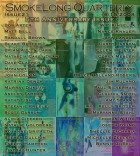One of my favorite things about “American Gothic” is how the story moves through time, the nonlinear progression, how time spins around the question of what the band will call their next album. Why did you decide to write the story this way? What would happen if you straightened time out and told the story linearly?
For a long time I wasn’t sure how to write this one. When I lived in Santa Cruz, I used to jog down to the ocean and through the boardwark and think about it. In my head it was then called “The Rock Stars of Littlewood Drive”—which was probably copped from Nathan Englander’s story, “The Gilgul of Park Avenue.” That’s telling, in a way—because the Englander story is this full, classic tale of complication. I think I thought my story would take that route too, but it never did. I had the nanny writing it for a while, in journal entries (this was before I’d heard of The Nanny Diaries). Probably the story would have run chronologically if I’d written it like that. In the end, the nonlinearity of “American Gothic” has to do with the choice of having the drummer narrate. I was happy with that choice, once I saw that it had been made. I’ve always liked that way of telling stories.
I like how the leader of the band, R., is only called by this one initial—it seems to enhance the kind of mysterious power he has over the story’s other characters. Why in fact is he called just R.? Have you been in bands yourself? Did you experience these kinds of power dynamics?
I think you’re right about the initial enhancing R’s power. Now on to the questions. One of them is easy: I’ve never been in a band. The other one’s hard: I don’t know why R. is called R! Probably it’s shortened. From what? I feel sheepish, not knowing. The sheepishness derives from Hemingway, probably—from those tales of all that detailed information he dreamed up about his characters but never put into his brief stories. Honestly, though? I don’t relate to Hemingway here. If you write your stories by feel—and most people do, I think—you have to try and limit distractions.
The painting American Gothic is an icon, perhaps the most well-known of any American painting. Why did you title the story that? Why does the band presumably end up calling their album that?
I was thinking about the Replacements when I started writing this story. Let me stress something before I go on: the Replacements seem to me FAR from a model for R’s group. But I was thinking about them. For a short while, in 1983 or ’84, they were the best band on the planet. And they knew it. They lived far from the action (sorry, Minneapolis), and they were on Twin Tone, which paid them royalties in cases of beer, but they were better than the Stones, who were selling out stadiums that year, and they were better than the Beatles sounded in retrospect. I’ve always seen the naming of their ’84 album, Let It Be, as an expression of this. Let It Be? That was the one thing you couldn’t name your album. It was, like, taken. But they could. They did.
That’s one way of answering the question.
As for me and the naming of my own story, I get my permission from R.
You edit the flash fiction magazine Wigleaf. Can you tell us a bit about it? Why did you start it? What is your attraction to flash fiction, both as a writer and an editor?
I just did an interview on this with Jim Ruland over at The Elegant Variation. So to keep myself entertained, I’m going to try to say different stuff.
Wigleaf may never have got off the ground if it hadn’t been for the Top 50 project, which was already in the works when I designed the first functional mock-up of the website. That project will be live by the time this interview runs—the Wigleaf Top 50 [Very] Short Fictions of 2008 (you’ll have to check it out right away, Joseph Young).
I didn’t have a very clear vision for the journal itself—not in advance I didn’t. I now see this as really lucky. I couldn’t have scripted in any exact way what’s ended up happening with Wigleaf. I’m remembering something Aaron Burch has said about Hobart: “We make it up as we go along”—something like that. Wigleaf really feels that way to me. All of these great people—readers, writers, editors—have come together in its invention.
As for flash fiction: I’ve encountered—often, it seems to me—a certain critical argument that goes something like this: ‘Flash fiction, though short, should have all the elements of any great fiction: compelling, fully-developed characters, fully arcing plots, etc.’ I have a hot-cold reaction to this. One the one hand, I think these writers and editors are completely right: very short stories are just that—stories. On the other hand… Let me put it this way: the very short story may have fully developed characters and plots, as its cousin, the short story, usually does. But it doesn’t have to. There are no rules yet, clear or tacit. That’s what makes the form so exciting right now. That’s why we’re seeing so much wildly original work being done within it. For me, certainly, that’s the attraction.
This issue marks SmokeLong‘s fifth anniversary, which has the staff thinking a lot about longevity and growth. There’s no denying the literary arena is fickle, with journals coming and going, writers shooting onto the scene then falling into a long hiatus, editors changing houses, agents merging, trends in what’s hot, what’s not. How do you, as a writer, endure the ups and downs? Have you experienced any setbacks? What measures have you taken to grow?
This is the common question, right? So I can count on others to provide a lot better answer than I will…
I don’t think about trends when I write. It’s not hard for me not to. It is unpleasant to get rejection letters, but even in the case of my most deeply out-of-fashion story (probably one called “The Lookalike,” which has something in common with Sherwood Anderson’s “I Want to Know Why”), I know that if I persist, I’ll find an editor, somewhere, who loves it and wants to extend it to readers. Ten years ago that wasn’t the case. There’s been a real broadening—which you guys, and the Indie Lit movement in general, are largely responsible for. I tip my hat to you, SmokeLong. It’s a ball cap, with two horn-like formations of dried sweat darkening the fabric beneath the bill. But I tip it to you all the same. Happy fifth B-day!



 The SmokeLong Grand Micro Contest (The Mikey) is now an annual competition celebrating and compensating the best micro fiction and nonfiction online.
The SmokeLong Grand Micro Contest (The Mikey) is now an annual competition celebrating and compensating the best micro fiction and nonfiction online.